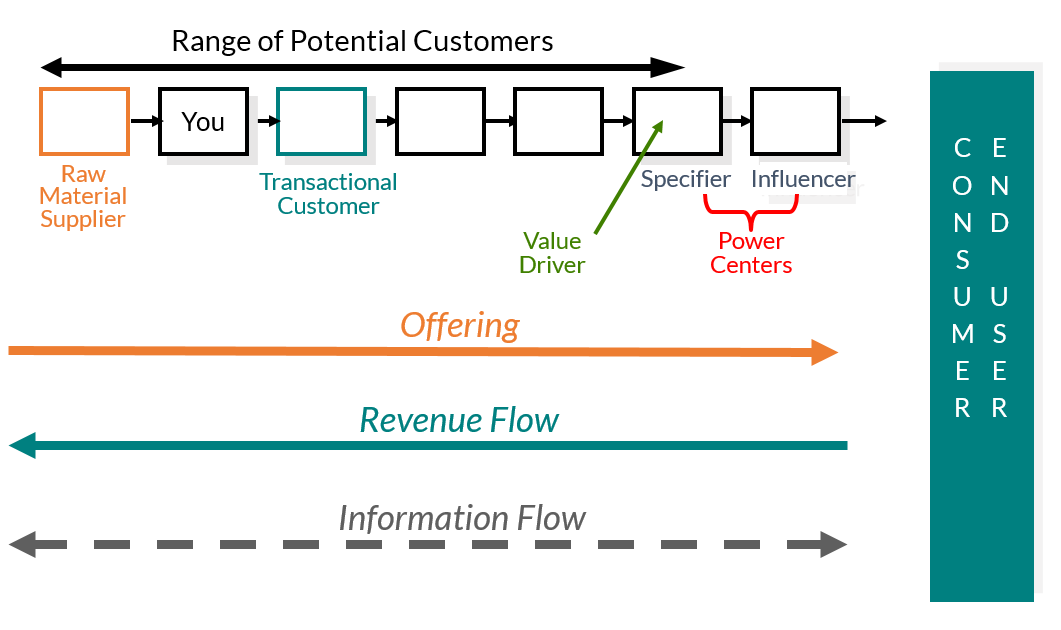The value-adding chain is the ecosystem in which your target market segment resides. It describes the relationship between suppliers and customers, from the initial supplier all the way to the end user customer. It also documents the critical success factors at every level of the chain.
Why Value-Chain Analysis?
Value chain analysis provides answers to the following questions:
- For whom does the opportunity under evaluation provide value?
- Where does the segment on which our marketing efforts focus fit?
- How should our marketing efforts be delivered?
- Where are the dynamics in the chain that may create opportunities to be addressed?
- What do we know about our customers that can guide our efforts to create and deliver greater value?
- How can we influence customers in favor of our offerings?
- What behavior should we expect from our competitors?
The value-adding chain must be generated with a specific “segment” in mind. Often, you will discover that there are more descriptive segments in the market than you thought.
Industries vs. Markets
Markets are subdivisions of the population who purchase specific products or services. They establish the basis for demand and are the source of all revenues. There are two types of markets to consider:
End use markets
the sets of companies who provide consumers with specific products and services
Application markets
the end user markets that use your value proposition in specific ways
An industry is a collection of value-adding activities that provide goods and services to end use markets. An industry has multiple participants (companies) who compete to provide solutions for end user customers. An industry is comprised of market segments, the groups of end user customers who have similar needs and act on your value proposition similarly.
As an example, let’s consider the air travel industry. The market is the people who use air transportation to travel from one location to another—business travelers, individual/pleasure travelers, charters, etc. The end use market is the airline companies and private planes (charters and co-shares) who provide air transportation. The market segments are the different types of airline companies, such as global carriers, regional carriers, and contract carriers.
Value-Adding Chain Operational Definitions
The chart below references the relationship between the value-adding chain and the SIPOC (suppliers, inputs, process, outputs, and customers) model.
There are three types of customers in the value-adding chain:
End user/consumer
derives useful value from your offerings. This is the last level in the value-adding chain
Customer
is anyone along the value-adding chain who comes into contact with (and can derive value from) your offering.
Transactional customer
is a company who exchanges goods and services for revenue.
Levels in the Value-Adding Chain
A level is the relationship between the members in the value-adding chain, according to the sequence by which value is transformed.
The value driver is the level in the chain that best interprets end user needs and values into specifications and represents (and sometimes dictates) them along the chain. The value driver typically “dictates” the terms of participation for other chain levels or is the specifications writer, and thus can be very powerful.
Power is the ability to influence or direct the performance of the total value-adding chain. This can significantly influence the use or specification of a product or service or set the standard for performance, form, and quality in the market. The power center is the level in the chain that affects what happens in the industry.
The value-adding chain influencer affects buying decisions made by targeted customers. The influencer may or may not purchase or handle products.
Vertical, forward, or back integration is when a portion of the value-adding chain or a participant in the value-adding chain undertakes the function of multiple steps in the value-adding chain. Forward integration designates toward the customer. Back integration designates toward the raw material producer. Both are examples of vertical integration.
Upstream designates toward the raw material producer. Downstream designates toward the consumer.
In our next blog post, we will look at building the value-adding chain map.






